Latin American Crop Protection Chemicals Market Size
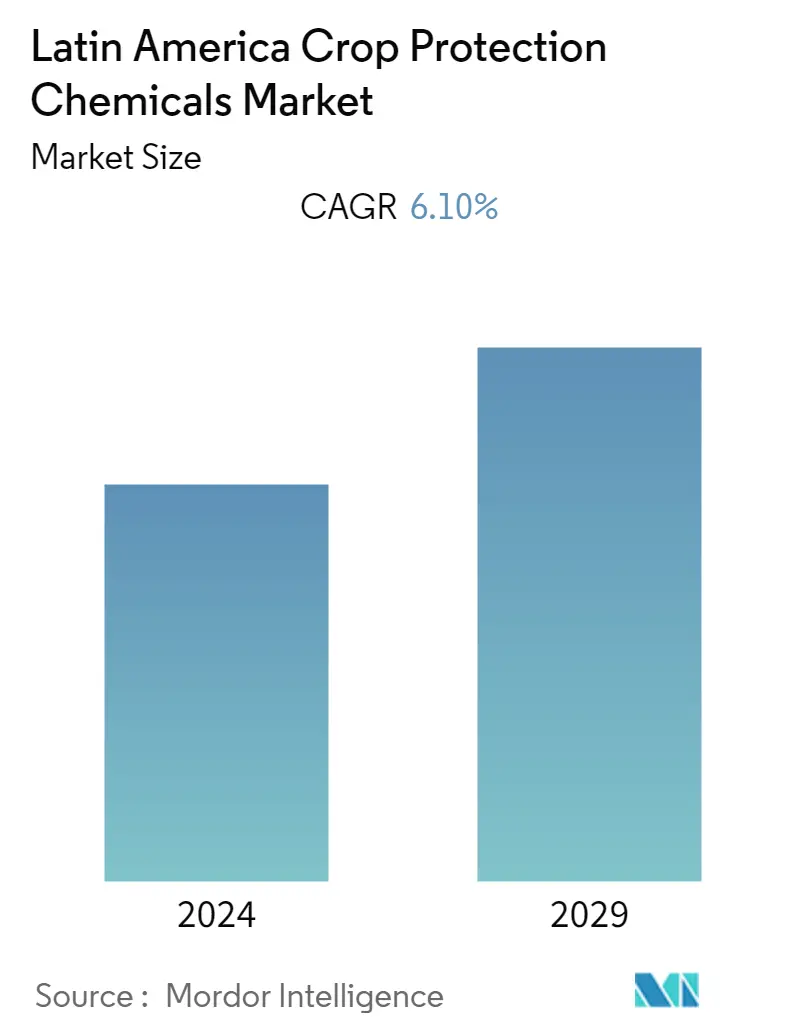
| Study Period | 2019 - 2029 |
| Base Year For Estimation | 2023 |
| Forecast Data Period | 2024 - 2029 |
| Historical Data Period | 2019 - 2022 |
| CAGR | 6.10 % |
| Market Concentration | High |
Major Players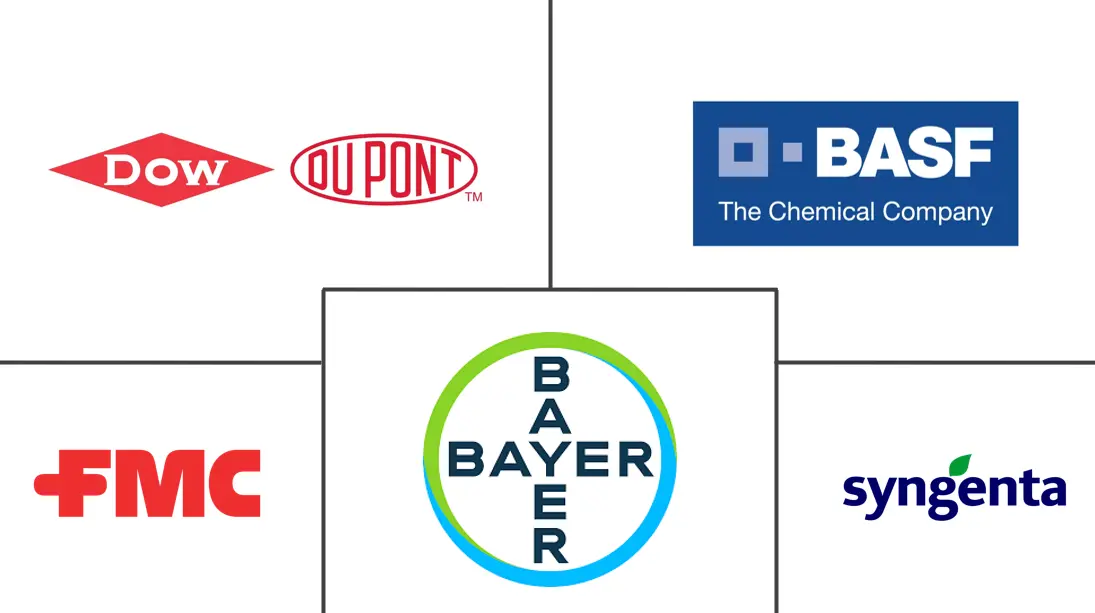
*Disclaimer: Major Players sorted in no particular order |
Latin American Crop Protection Chemicals Market Analysis
The Latin American crop protection chemicals market is poised to register a CAGR of 6.1% during the forecast period.
- Latin America has the potential to be the global breadbasket of the world because of its rising use of innovation and investment in sustainable agriculture. Finding sustainable ways to feed the rapidly increasing population while satisfying the evolving and diverse dietary needs of the growing global middle class is an opportunity that can be utilized by Latin America. Therefore, the provision of crop protection chemicals plays an important role.
- The Latin American region is a significant exporter of a variety of crops, of which the most significant include soybeans, maize, cotton, sugar, orange juice, coffee, bananas, ornamentals, cocoa, grapes, apples, and other fruits. Pesticides are essential components for the production of these crops and for maintaining export levels. In certain cases, pesticides also supplement ecologically sound practices, such as no-till, which helps preserve soil fertility in the region.
- Globally, the Latin American market is the second-fastest-growing market for crop protection chemicals, and it accounts for more than 23% of the global market share. Joint ventures and new product launches are the major strategies followed by Latin American companies. The pesticide market in Latin America is consolidated, with the top few companies holding the major share, whereas the biopesticide market is fragmented.
Latin American Crop Protection Chemicals Market Trends
This section covers the major market trends shaping the Latin America Crop Protection Chemicals Market according to our research experts:
Adoption of Genetically Modified (GM) Crops
The use of genetically modified (GM) organisms is the new trend in the market. Due to decreasing arable land in the Latin American region, GM crops are highly preferred to maintain productivity levels. GM crops require a significant amount of crop protection chemicals, which play a vital role in proper growth and good-quality harvests.
Brazil and Argentina are both among the top five GM-cultivating countries. Latin America, along with Bolivia, Chile, Colombia, Costa Rica, Honduras, Paraguay, and Uruguay, cultivated 42.7% of the global GM crop area. On the other hand, Brazil and Argentina have chosen an opposite strategy, enabling, purposefully, and fiercely embracing biotech innovation and transforming South America into a global leader in GM crop production. With the adoption of GM crops in these countries, cultivation is anticipated to increase, which is anticipated to have a positive impact on the crop protection chemicals market in the region.
The benefits of transgenic crops include saving water and reducing emissions of carbon dioxide, which help preserve many trees. These crops contain disease-resistant, herbicide-resistance, and drought-resistant genes. Brazil has the largest area under the cultivation of GM crops.
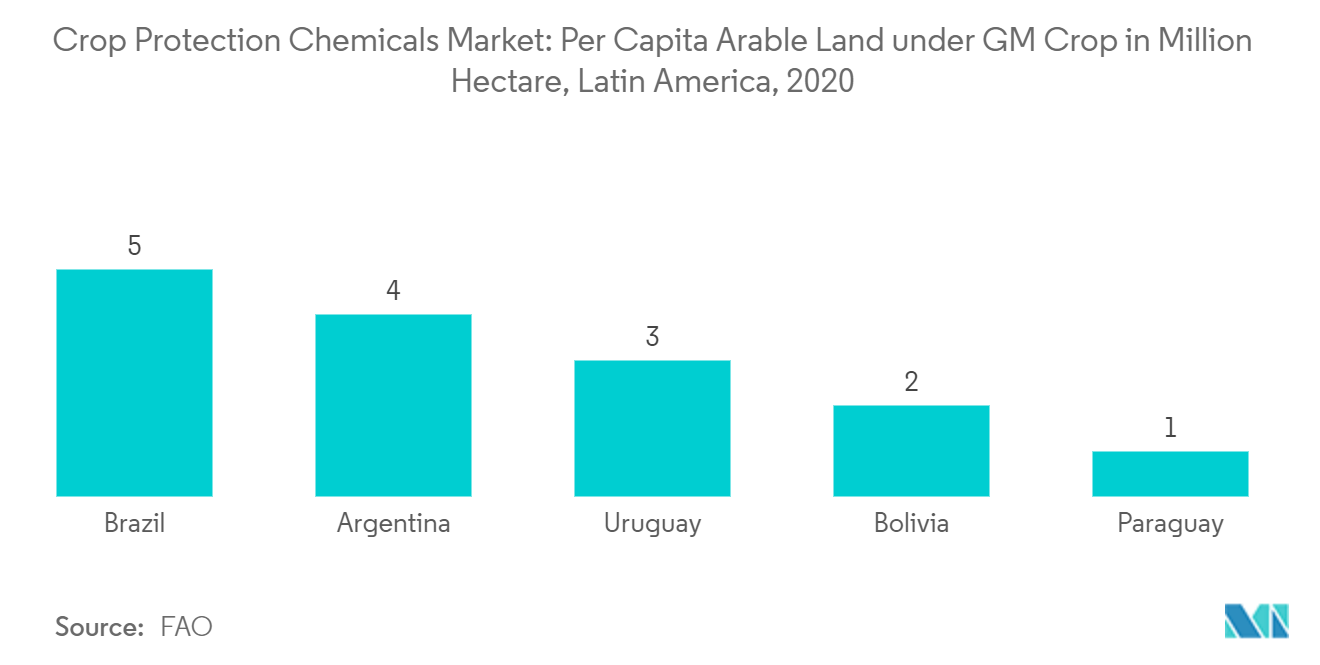
Brazil Dominates the South American Market
Brazil has the largest and one of the fastest-growing markets for crop protection chemicals in South American countries. Brazil has developed from a net food importer to a major exporter, mostly by improving productivity through technology adoption and the use of crop protection chemicalso a major exporter, mostly by improving productivity through technology adoption and the use of crop protection chemicals. Although production has been witnessing a smaller decline, it is expected to rebound with more use of crop protection chemicals.
Glyphosate is the best-selling crop protection product in Brazil. It is used mainly on crops like soy, corn, wheat, cotton, and coffee. The herbicide tops the list of the most commercialized agrochemicals in the country, according to a survey by the G1 agency released by the Brazilian Association of Post-Patent Defensives (AENDA). The herbicide 2,4-D is also the second-best-selling crop protection product in Brazil. Its mode of action is different from glyphosate, controlling only one group of weeds. It is one of the bestsellers as it helps manage the resistance that many weeds have developed against glyphosate.
The fungicide, mancozeb, is the third most sold in Brazil and also the oldest. It is again being widely used for controlling a major soy disease, Asian rust, normally mixed with more modern products to ensure the effectiveness of newer products that were losing their effectiveness against the disease. Chinese and Indian companies have been entering Brazil through distribution systems and/or as registration holders, moves that are considered much more lucrative than just supplying products to local distributors.
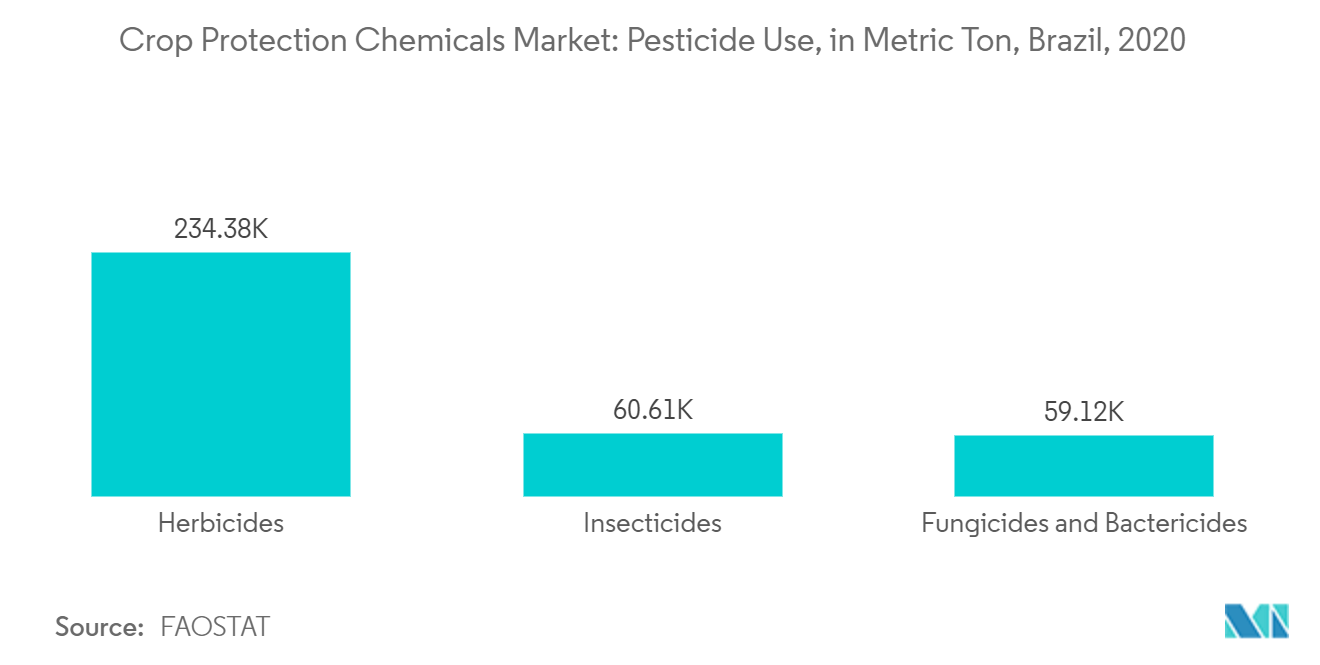
Latin American Crop Protection Chemicals Industry Overview
The Latin American crop protection chemicals market is highly consolidated, with the top few companies holding a large share of the market while the rest is held by other multinational and local companies. BASF SE, DowDuPont, Bayer, FMC Corporation, and Syngenta AG are some of the key players with high market shares. New product launches, mergers and acquisitions, and partnerships are the major strategies adopted by the leading companies in the market. These companies also focus on making investments, mainly in new product development, to increase their market share.
Latin American Crop Protection Chemicals Market Leaders
-
Bayer CropScience AG
-
Syngenta AG
-
BASF SE
-
DowDuPont
-
FMC Corporation
*Disclaimer: Major Players sorted in no particular order
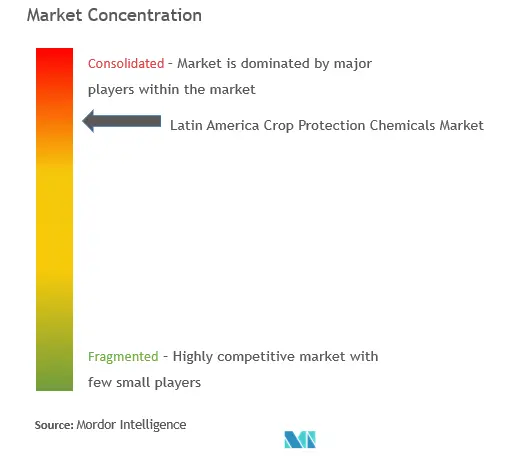
Latin American Crop Protection Chemicals Market News
- November 2022: Bayer launched Adengo, a pre-emergent herbicide that has two active principles with different mechanisms of action: isoxaflutole and thiencarbazone, guaranteeing a broad spectrum of control and acting on both broad leaves and narrow sheets.
- July 2022: BASF announced the launch of the fungicide Zampro (Ametoctradin + Dimethomorph) in Brazil. The new fungicide is indicated for the control and management of diseases such as late blight and mildew and can be used in a variety of cultures, with a focus on tomato, grape, and potato crops.
- May 2022: BASF presented a new biological fungicide that is widely recommended for use on fruits and vegetables and that, in principle, is available in the country for strawberries and raspberries by the name of Serifel, formulated with Bacillus amyloliquefaciens. BASF is marking its entry into the biological segment in Argentina.
Latin American Crop Protection Chemicals Market Report - Table of Contents
1. INTRODUCTION
1.1 Study Assumptions and Market Definition
1.2 Scope of the Study
2. RESEARCH METHODOLOGY
3. EXECUTIVE SUMMARY
4. MARKET DYNAMICS
4.1 Market Overview
4.2 Market Drivers
4.3 Market Restraints
4.4 Porter's Five Forces Analysis
4.4.1 Bargaining Power of Suppliers
4.4.2 Bargaining Power of Buyers
4.4.3 Threat of New Entrants
4.4.4 Threat of Substitute Products
4.4.5 Intensity of Competitive Rivalry
5. MARKET SEGMENTATION
5.1 Origin
5.1.1 Synthetic
5.1.2 Bio Based
5.2 Mode Of Action
5.2.1 Herbicide
5.2.2 Fungicide
5.2.3 Insecticide
5.2.4 Other Modes of Action
5.3 Application
5.3.1 Grains and Cereals
5.3.2 Pulses and Oilseeds
5.3.3 Fruits and Vegetables
5.3.4 Commercial Crops
5.3.5 Turf and Ornamentals
5.4 Geography
5.4.1 Brazil
5.4.2 Argentina
5.4.3 Chile
5.4.4 Rest Of Latin America
6. COMPETITIVE LANDSCAPE
6.1 Market Share Analysis
6.2 Most Adopted Strategies
6.3 Company Profiles
6.3.1 Adama Agricultural Solutions Ltd
6.3.2 BASF SE
6.3.3 Bayer CropScience AG
6.3.4 Isagro SpA
6.3.5 FMC Corporation
6.3.6 Marrone Bio Innovations Inc.
6.3.7 Syngenta AG
6.3.8 Sumitomo Chemical Co. Ltd
6.3.9 Nutrien Ltd
6.3.10 Corteva Agrisciences
7. MARKET OPPORTUNITIES AND FUTURE TRENDS
Latin American Crop Protection Chemicals Industry Segmentation
Crop protection chemicals constitute a class of agrochemicals used to prevent crop deterioration from insects and pest infestation. The Latin American Crop Protection Chemicals Market is Segmented by Origin (Synthetic and Bio-Based), Mode of Action (Herbicide, Fungicide, Insecticide, and Other Modes of Action), Application (Grains and Cereals, Pulses and Oilseeds, Fruits and Vegetables, Commercial Crops, and Turfs and Ornamentals), and Geography (Brazil, Argentina, Chile, and Rest of Latin America). The report offers market size and forecasts in terms of Value (USD Million).
| Origin | |
| Synthetic | |
| Bio Based |
| Mode Of Action | |
| Herbicide | |
| Fungicide | |
| Insecticide | |
| Other Modes of Action |
| Application | |
| Grains and Cereals | |
| Pulses and Oilseeds | |
| Fruits and Vegetables | |
| Commercial Crops | |
| Turf and Ornamentals |
| Geography | |
| Brazil | |
| Argentina | |
| Chile | |
| Rest Of Latin America |
Latin American Crop Protection Chemicals Market Research FAQs
What is the current Latin America Crop Protection Chemicals Market size?
The Latin America Crop Protection Chemicals Market is projected to register a CAGR of 6.10% during the forecast period (2024-2029)
Who are the key players in Latin America Crop Protection Chemicals Market?
Bayer CropScience AG, Syngenta AG, BASF SE, DowDuPont and FMC Corporation are the major companies operating in the Latin America Crop Protection Chemicals Market.
What years does this Latin America Crop Protection Chemicals Market cover?
The report covers the Latin America Crop Protection Chemicals Market historical market size for years: 2019, 2020, 2021, 2022 and 2023. The report also forecasts the Latin America Crop Protection Chemicals Market size for years: 2024, 2025, 2026, 2027, 2028 and 2029.
Crop Protection Chemicals in Latin American Industry Report
Statistics for the 2024 Crop Protection Chemicals in Latin American market share, size and revenue growth rate, created by Mordor Intelligence™ Industry Reports. Crop Protection Chemicals in Latin American analysis includes a market forecast outlook to 2029 and historical overview. Get a sample of this industry analysis as a free report PDF download.



